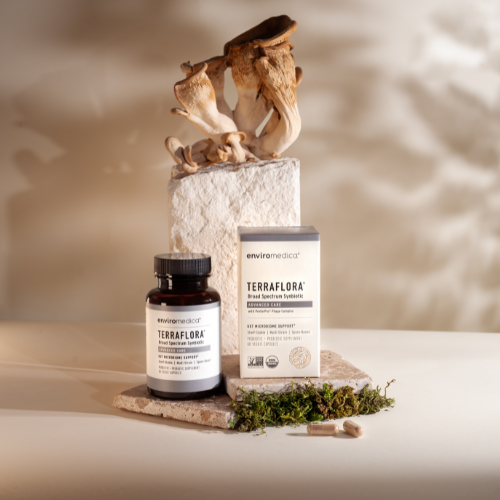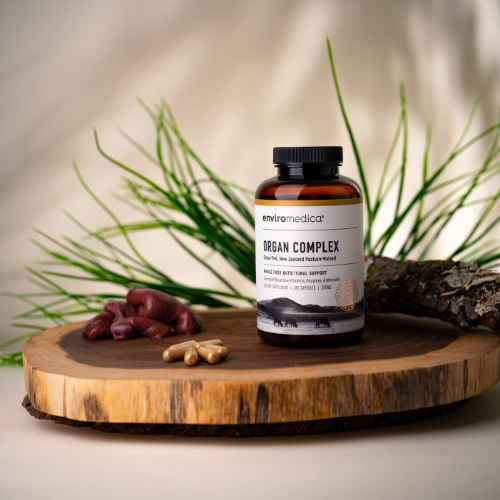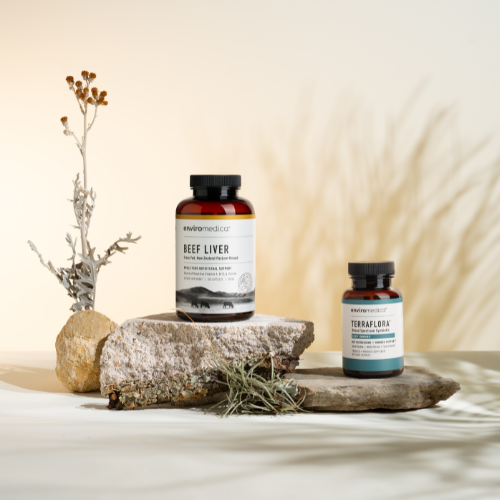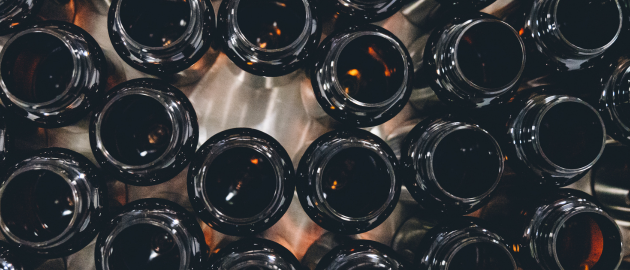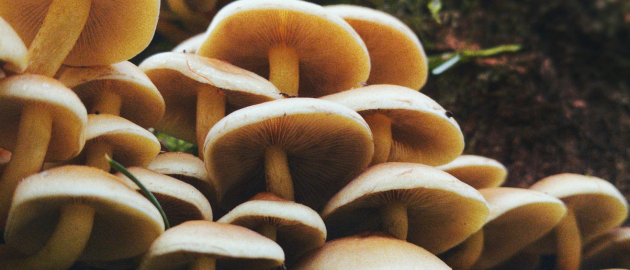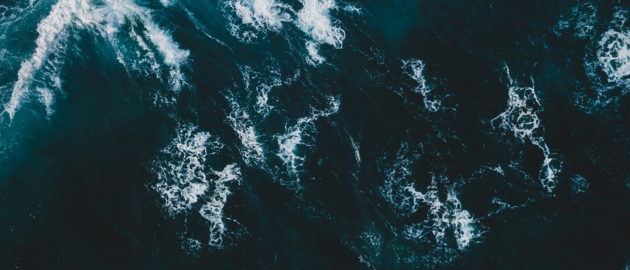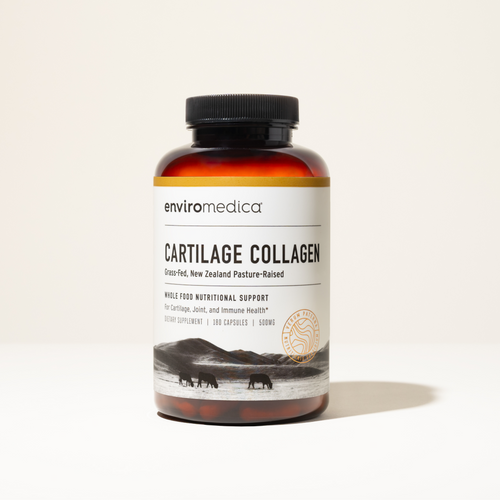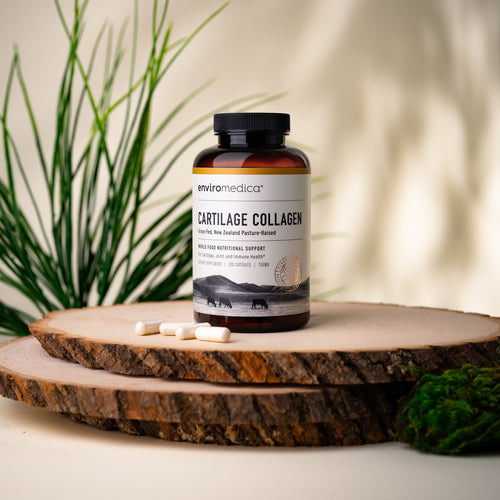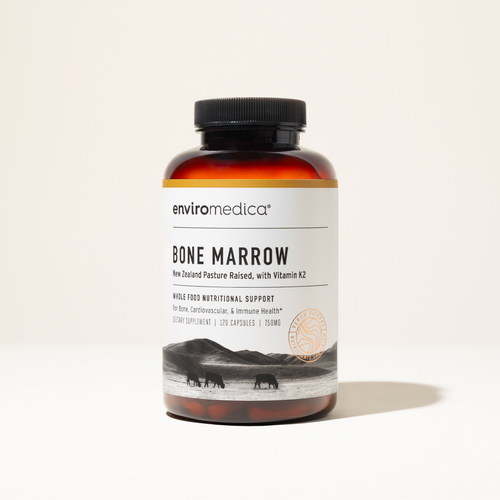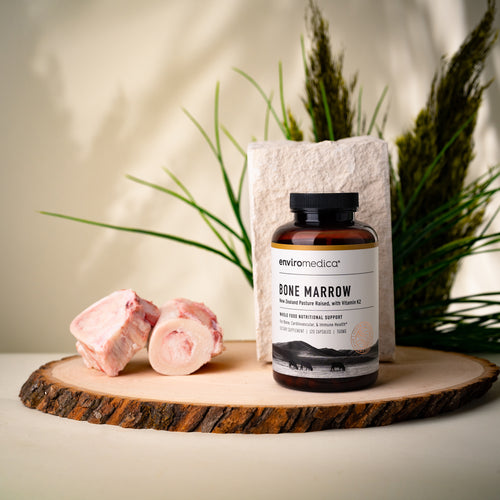Collagen
In Biology 101 we learned the human body has skeletal, circulatory, respiratory, reproductive, excretory, endocrine, nervous, digestive, immune, lymphatic, muscular, and integumentary (skin) systems. Add to this list a more recent understanding that we host a microbial system referred to as ‘the forgotten organ’ that interacts with nearly all other systems in some way.1 2
Question: What holds all of these systems together to form your body?
Answer: A network of connective tissues and extracellular matrix (ECM). The primary ‘glue’ in this connective support system is a protein known as collagen.3
Collagen is the substance that makes skin appear smooth and hydrated giving it resiliency, it helps joints move freely and painlessly, and keeps the gut and organ systems healthy. Collagen is lost as a function of age and of lifestyle. It is possible to maintain collagen levels in your body over time to experience what some might perceive to be a fountain of youth.
Read on to discover the basics of collagen, where it is found, what systems it supports, what lifestyle factors deplete it, and how to prevent the loss of collagen in your body to enable yourself to move painlessly with grace as you age.
Collagen Basics
The etymology of the word ‘collagen’ is informative. It originates from the Greek word ‘Kolla’ meaning ‘glue’, and the French word ‘gène’ meaning ‘born of’ or ‘origin’.4 5
Collagen, the protein that holds a human body together, is recognized to be the most abundant protein in the animal kingdom, comprising 30% of all protein by mass.6 7
As all proteins are, collagen it is derived from amino acids. Amino acids are provided to the body in a number of ways. The most familiar way is by consuming foods made of protein. The body can also mine protein from our tissues if we experience a starvation state.8 Interestingly, a fraction of amino acids may be manufactured and regulated in the body by gut microbiota. 9 10 11 This relatively new discovery illuminates new pathways of research on the role of gut health in building and regulating function of body tissues.
Collagen is created in the body in a process that begins inside the cell and ends in the extracellular environment. A specific group of cells is integral in collagen synthesis, including: Mesenchymal cells (and those derived from them), epithelial and endothelial cells, muscle cells, and Schwann cells.12
Amino acids circulating in the bloodstream are translocated into the cytoplasm of these cells in a sodium-dependent process enabled by membrane-bound transporter proteins.13 Once inside the cell, amino acids (such as glycine, proline, lysine – a.k.a protocollagen) are hydroxylated (-OH group added to them) with the help of vitamin C in the endoplasmic reticulum (ER). 14 15 16
The hydroxylated amino acids then go through glycosylation (sugar is added) in the ER allowing for the formation of the characteristic procollagen triple helix structure. Finally, carbohydrates are added in the cellular Golgi body to create oligosaccaride chains that exit the cell via the process of exocytosis. 17
At this stage, procollagen is now in the extracellular matrix where it is cleaved by procollagen peptidases. The resulting structure is known as tropocollagen. With the assistance of fibronectin, tropocollagen is covalently bonded together to form collagen fibrils, beaded filaments, anchoring fibrils, and collagen networks that shape our bodies.18 19 20
28 members of the collagen family are currently recognized throughout the animal kingdom and the human body. Collagen I – Collagen XXVIII are each identified with a distinct genetic, structural, and molecular composition. Different types of collagen protein are found in association with various parts of the body and in associateion with various pathologies as listed in Table 1.21 22 23 As noted above, the skeletal, circulatory, respiratory, reproductive, excretory, endocrine, nervous, digestive, immune, lymphatic, muscular, and integumentary (skin) systems all contain various types of collagen and are held together largely by collagenous materials.
| Table 1. Types of Collagen | ||
| Type | Location | Associated Pathologies |
| Collagen I | Most abundant, in nearly all tissues: skin, tendon, bone, ligaments, dentin, interstitial 24 | osteogenesis imperfecta, osteoporosis, Ehlers-Danlos syndrome 25 |
| Collagen II | Cartilage, vitreous humor | Osteoarthritis, chondrodysplasias26 |
| Collagen III | Skin, blood vessels, intestine, uterus, muscles | Ehlers-Danlos syndrome, arterial aneurisms27 |
| Collagen IV | basal lamina, ECM under the epithelium, eye lens, kidney | Alport syndrome, Goodpasture’s syndrome28 29 |
| Collagen V | widespread, bone, dermis, cornea, interstitial matrix, placenta | Ehlers-Danlos syndrome30 |
| Collagen VI | widespread, bone, dermis, cornea | neurological health, bethlem myopathy, atopic dermatitis (18) 31 |
| Collagen VII | dermis, bladder | Epidermolysis, bullosa acquisita 32 |
| Collagen VIII | dermis, brain, kidney, heart | Fuchs endothelia, corneal dystrophy 33 |
| Collagen IX | cartilage, cornea, vitreous | Osteoarthrosis, Multiple epiphyseal dysplasia 34 |
| Collagen X | cartilage | Chondrodysplasia 35 |
| Collagen XI | cartilage, intervertebral disc | chondrodysplasia, osteoarthrosis 36 |
| Collagen XII | dermis, tendon | Bethlem myopathy 37 |
| Collagen XIII | endothelial cells, dermis, eye, heart | neuromuscular synapse function, congenital myasthenic syndrome38 |
| Collagen XIV | widespread, bone, dermis, cartilage, heart | left ventricular wall thickening39 |
| Collagen XV | basement membrane, capillaries, testis, kidney, heart | tumor metastasis40 |
| Collagen XVI | dermis, kidney, intestine | tumorigenesis and inflammation41 |
| Collagen XVII | epithelia | Generalized Atrophic epidermolysis bullosa42 |
| Collagen XVIII | basement membrane, liver | Knobloch syndrome43 |
| Collagen XIX | basement membrane, expressed by central neurons | hippocampal synapse function44 |
| Collagen XX | cornea 45 | |
| Collagen XXI | stomach, kidney, blood vessel walls 46 | |
| Collagen XXII | tissue junctions | pathologies of myotendinous junction47 |
| Collagen XXIII | heart, retina, epidermis, gut, lung, brain kidney | biomarker for prostate cancer48 |
| Collagen XXIV | bone, cornea (28) | |
| Collagen XXV | brain, heart, testis | amyloid formation?49 50 |
| Collagen XXVI | Testis, ovary51 | |
| Collagen XXVII | Cartilage, skin, lung, cornea, retina, heart52 | |
| Collagen XXVIII | dermis, sciatic nerve | neurodegenerative disease?53 54 |
Each collagen molecule is composed of long protein chains of repeating amino acid triplets. Each triplet is composed of glycine plus two other amino acids, typically proline and hydroxyproline.55 56 57
The different collagen types vary in length of amino acid chains that compose them (from 662 to 3152 amino acids in Types X and VI, respectively) and the percentage of characteristic ‘triple helix’ structures within them (96% of Type I is characterized by the triple helix structure, less than 10% for Type XII).58 It is likely that the abundance of the triple helix structure associated with each collagen type is associated with its thermal stability and how energetically active it is. 59
______________________________________________________________________
As an aside, the triple helix structure is an amazing functional shape designed by nature. The collagen triple helix is described by Shoulders and Raines (2009) in these words: ‘This fibrous, structural protein comprises a right-handed bundle of three parallel, left-handed polyproline II-type helices.’ If you’ve ever made cordage from raw materials (or disassembled a rope), you’ll recognize the strength and resiliency that results when twisting individual strands one way, and twisting them together in the opposite direction.
______________________________________________________________________
80-90% of all currently recognized collagen in the body is characterized as Collagen I, II, or III, all known as ‘fibrillar collagens’. These collagen types are reviewed in more detail below.
Collagen I – Collagen I is the most ubiquitous collagen in the body. Collagen I in a healthy body is a ‘heterotrimer’ molecule, meaning it is composed of differing amino acids chains, namely 2 α1(I) and 1 α2(I) chains. There is a ‘homotrimer’ of Collagen I composed of all the same amino acid chains, the α2(I) chain is replaced with another α1(I) chain. The later creates a weaker collagen structure found only in fetal tissues, fibrosis, and cancerous tissues.60 Heterotrimer Collagen I, the stronger variant, is represented in most tissues, including bone, skin, tendon, ligament, dentin, cornea, blood vessel walls, and interstitial tissues.61 62 The triple helix structure of Collagen I is naturally metastable under physiological conditions.63 64 Collagen I provides stiffness, durability, and strength to tissues it is present in.65
Collagen II – Collagen II is primarily found in cartilage and in vitreous humor (the transparent tissues inside of the eyeball). Collagen II molecules are ‘homotrimer’; composed of 3 α1(II) chains.66 It is found in abundance in association with tissues that experience compressive loads such as tendon attachments points.67
Collagen III – Collagen III is always found in association with Collagen I in the skin, muscles, and blood vessels. It is composed of 3 α1(III) chains.68 Collagen III fibrils are physically thinner than Collagen I fibrils and are found in higher concentration in areas that are more elastic, such as skin and blood vessels. Collagen III is functional in the healing process where it is randomly oriented around the site of a wound. It is eventually replaced with more aligned Collagen I fibrils as the healing progresses.69
The Importance of Collagen
Besides its ubiquity in the human body, there are a number of specific reasons why it is important to ensure your body has access to, and can assemble the building blocks of collagen. Collagen is imperative for gut health, skin health, strong hair and nails, the health of your muscles, tendons, joints, ligaments, eyes, brain, bone, and heart. Collagen influences the shape and integrity of nearly all human systems and tissues.
Gut health. Collagen is a primary component of extracellular matrix and your connective tissues, but it can be argued that one of its most important roles in the human body is to maintain the integrity of the gut barrier. Gut barrier dysfunction is implicated in the pathogenesis of inflammatory bowel disease, irritable bowel syndrome, obesity, celiac disease, food allergies and sensitivities, and autoimmunity.70 71 72 73 74 It is hypothesized that, in the presence of sufficient ascorbate (vitamin C), collagen is derived from intestinal smooth muscle tissue to heal local tissues 75 In addition, the amino acid components of collagen, proline and glycine, are known to be protective of the gut lining. 76 77
Glycine is located at every third position in the collagen matrix. 78 It is known to have an anti-inflammatory and immunomodulatory effect in the body and is cytoprotective of intestinal epithelial cells. 79 80 81
Razak et al. (2017) review the benefits of glycine not only for gut health, but for liver detoxification processes, wound healing, inhibition of macrophage and inflammatory processes, its role in successful organ transplant processes, as a treatment endotoxic shock, as a preventative for arthritis, to treat gastric ulcers, and as a cancer therapy. With respect to gut health, they note that glycine supplementation has successfully treated people for intestinal disorders (including inflammatory bowel disease) 82 and suggest that study of glycine receptors on epithelial and immune cells be a target of further study to understand better why glycine appears to be so healing to the gut.
Skin. Perhaps one of the most obvious benefits to collagen sufficiency is visual. Collagen supports elasticity of skin. Varani et al (2006) notes that humans naturally have 75% less collagen at age 80 than they do at age 20 to 80. 83 We observe this collage loss through wrinkles associated with aging. 84
Nails. Your nails are constantly growing and changing in response to the nutrients available to your body. They essentially document your health over the past year. 85 86
Muscle growth and maintenance. Collagen I & III are the predominant collagen types found in muscle. In response to injury, collagen III increases at the site of injury relative to collagen I. Collagen is a functional component of muscle and aids in its growth, repair, and resiliency. 87
Joints. Joint pain is an all too common complaint in modern society. Collagen makes up a large part of joint, where cartilage, bone, connective tissue, and extracellular matrix meet.
Eyes. More than 70% of the dry weight of the eyeball is composed of collagen types I, II, III, V, and VI. note]Shoulders, M. D. & Raines, R. T. 2009. Collagen structure and stability. Annu Rev Biochem, 78, 929-58[/note] 88 89
Brain Health. Collagen is important for mental health. Loss of collagen VI promotes apoptosis and defective autophagy in neural cells leading to neurodegeneration. 90 Extracellular proteins appear to be protective to the central nervous system as we age.
Heart. Cardiovascular health is largely dependent on collagen. The elasticity and resiliency of the heart muscle and blood vessels are integral to optimal cardiovascular function. 91 92
Without sufficient collagen, our bodies would quite literally fall apart. This protein is so integral to our health and wellbeing, but we tend to lose it over time. Why is this?
What influences collagen?
Collagen loss in the human body is associated with aging and a number of modern lifestyle choices and consequences including: sugar consumption, smoking, nutrient deficiency, an overfed state, excess sun exposure, and lack of mechanical load.93 95 96 97 98 99 100 101 102 103 104 105 106 107 While you can’t stop the effects intrinsically related to time, you do have control over extrinsic variables involved.
Aging. Collagen loss is observed to occur with age. There is a natural cycle to life, just as diets change from infancy through adulthood, so do biological processes and the materials that compose us. It is challenging to tease out intrinsic factors of collagen loss related to age alone. Collagen types I and III have been observed to decrease by 75% with age,108 possibly because fibroblasts (a cell that produces connective tissue) age and tend to be less mechanically stimulated. More cell surface area attaches to collagen fibers in younger individuals (18-29 years) than in older individuals (80+ years) in sun-protected skin.109 Lack of cellular attachment to collagen might be the cause of decreased mechanical stimulation (tension), or might be the result of it. We witness the effects of aging on our skin and collagen loss is an important part of the change in the elasticity and structure that we observe.
Sugar. When sugar is consumed, it enables connective tissue damage in the form of increased stiffness and failure strength through the process of creating ‘advanced glycation end-products’ (AGEs).110 AGEs are formed when sugar in the body is reduced and attached to free amino groups creating highly reactive dicarbonyl compounds. The formation of AGEs and their cross linkage to collagen in the body has been associated with increased susceptibility to injury, compromised healing capacity, and overall tissue dysfunction. 111 Typically, these processes are correlative with Type 2 diabetes, a diagnosis that nearly one-third of the US population stands to receive in the coming years.112 113 Sugar in the body speeds collagen loss and overall health decline.
Smoking. Collagen-loss risk factors are interrelated. Smoking is a lifestyle choice that – just like sugar consumption, exaggerates the production of AGEs.114 In a skin study of smokers vs. non-smokers, investigators conclude that extracellular matrix turnover in the skin of smokers is disrupted and the production rates of Collagen Type I and III were decreased by 18% and 22%, respectively. 115 A study of lung tissue in smokers shows that cigarette smoke disaggregates collagen, leading to neutrophil (white blood cell) infiltration, chronic inflammation, and ultimately an emphysema diagnosis. 116
Nutrient deficiency. There are a number of co-factors involved in collagen formation and as such, deficiency in any one of them can lead to collagen loss. Protein provides the major building blocks for collagen and sufficient consumption of quality protein is critical in collagen synthesis. Vitamin C is a co-factor for collagen synthesis, stabilizing the triple helix structure of collagen. 117 Copper plays a critical role in collagen synthesis in and integrity of the cardiovascular system 118 119 Copper deficiency manifests in weakened heart and vascular structures, increasing the likelihood of aneurysm. 120
As previously mentioned, the formation of protocollagen requires that amino acids be translocated into the cell in a sodium dependent process. Ivanov et al (2016) demonstrate that sodium and calcium channel blockers – prescribed for a number of health issues, including cardiac arrhythmias – effectively decrease the deposition of Collagen I & IV in the body.121 It stands to reason that natural salts are expected from the body and important to the production of collagen.
Collagen synthesis can be related to overall cellular health as collagen formation takes place both inside cells and in the extracellular environment. Nutritional support for general mitochondrial health has a spotlight on it as a result of Dr. Terry Wahls personal and clinical work on reversing symptoms of Secondary Progressive Multiple Sclerosis.122 So far, mitochondrial health is implicated in collagen formation with respect to asthma therapies,123 hyaluronic acid in osteoarthritis,124 thyroid hormone sufficiency and skin health,125and extrinsic factors in skin aging. 126 Eating for mitochondrial health is then supportive of collagen health and collagen maintenance in the body. It appears that mitochondrial health requires nutrients found in green leafy vegetables, sulfur-rich vegetables, intensely colored vegetables, omega-3 fatty acids, and animal proteins for B-12.127
Caffeine. The results of laboratory experiments show that caffeine intake inhibits collagen biosynthesis in a dose dependent way. 128 Caffeine appears to inhibit prolidase enzyme activity; an enzyme that liberates proline from the collagen matrix.129
Nutrient oversufficency. In our modern environment, it is very easy to be overfed and undernourished. There is substantial evidence that caloric restriction (without malnutrition) delays the aging process perhaps due to: altered hormone metabolism, change in oxidation status, DNA repair, or apoptosis. In laboratory study, caloric restriction stimulated an increase in both fibroblast density and collagen in the skin of rats.130 Perhaps our bodies require balance to function optimally. Chronic over-nourishment is a condition that we are not historically conditioned for.
Excess sun. While the sun is a nutrient that we require for life, in excess in our modern world it can physically degrade skin in a process known as photoaging.131 132 Photoaging, or premature aging, varies between individuals dependent on ethnicity, genetic predisposition, and the amount of exposure. Ultraviolet (UV) A, UV-B, and infrared (IR) A rays from the sun penetrate the skin to trigger mitochondrial and telomere damage, receptor-initiated and arylhydrocarbon signaling, and protein oxidation.133 Through the formation of reactive oxygen species (ROS) and a resultant cascade of cell surface processes, solar radiation both inhibits the production of Collagen I and III and damages pre-existing collagen through the synthesis of ‘metalloproteinase’ (MMP) in the skin.134 135
Lack of mechanical load/stimulation. It is common knowledge that lean muscle tissue increases in response to mechanical stimulation, but it is less common knowledge that collagen increases in response to mechanical stimulation. Several studies demonstrate an increased genetic expression of collagen in response to mechanical stimulation in efforts to help repair bone, ligaments, and tendon.136 137 Collagen turnover and synthesis – that make tissue even more load resistant – increase after exercise.138 139 Extracellular matrix adaptation of tendon and skeletal muscle to exercise. J Anat, 208, 445-50 Movement is a positive feedback loop for collagen synthesis, tissue repair, and general health.
Skin massage and stimulation have been studied as a method to increase collagen for anti-aging efforts. Researchers found that a stimulus frequency of 75Hz increased certain protein expression in the dermis and epidermis, leading to visible reduction of wrinkles.140
From an ancestral point of view, the material we discuss as ‘collagen’ was unlikely to be a topic of conversation. Aged skin was simply a result of ‘age’, characterizing ‘elders’ and wisdom or experience. There was no chance of overconsumption of sugar. Nutrients were harvested from the land, literally in trade for the work required to hunt and gather them. The entire animal was consumed, including connective tissues and organs, enabling protein and nutrient sufficiency for collagen biosynthesis. ‘Caloric restriction’ translated to the time in between successful hunts. There was no coffee shop to stop off on your way to work; the only native source of caffeine to the US is yaupon, or holly. Air pollution was restricted to the smoke from a fire. In other words, the extrinsic factors for collagen loss are a completely modern phenomenon.
It behooves us to supply the highest quality biological materials to our bodies, control our environment to the extent that we can, and use our bodies in a way that nature expects them to be used. Collagen is a large and clearly integral part of the body. Can you support your health by supplementing with collagen?
Collagen Supplementation
The environment, developed skill-sets, economy, community, and understanding of available resources are vastly different today than they were during our ancestor’s lives. Modern western society is unlikely to feed exclusively on wild game or have the time and know-how to put in the work to secure that food. As noted above, the modern lifestyle as a whole is not collagen-friendly and the time and effort it might take to get to a more ‘collagen-friendly’ place can seem overwhelming. While it is always advisable to change diet and lifestyle choices to support health goals, there is a place for supplementation toward achieving those goals. Can you supplement collagen and receive health benefits? Fortunately, there are a number of studies and clinical trials that demonstrate health benefits from supplementing with collagen to provide the body with the building blocks to biosynthesize and remodel its own collagen proteins. Below is a brief review of some of those studies.
First and foremost, how do we know if collagen that we eat becomes part of our collagen matrix? Besides the old saying, ‘you are what you eat’, there is scientific evidence to support this has some truth. Oesser et al (1999) radiolabeled gelatin (a product of high temperature processing of collagen, or denatured collagen) and fed it to mice. Radiolabeling protein enabled them to determine where in the body it would end up. They discovered that gelatin consumed accumulated in the cartilage of the mice.141
Chen et al. (2017) propose that collagen peptides (in this case, derived from the skin of Alaska pollock) have the ability to can enhance tight junctions in the gut wall.142 Their study utilized a human colonic adenocarcinoma (Caco-2) cell line culture well known to simulate enterocyte (cells that line the gut) function ex vivo. 143 After experimentally inducing gut barrier dysfunction in the model using a cytokine known to cause intestinal permeability (tumor necrosis factor-alpha, TNF-α), Chen et al. (2017) observed that the glycine-rich low antioxidant collagen peptide “completely abolished” the TNF-α at a dose of 0.5-2.0 mg mL-1.144 In other words, the presence of collagen is associated with the disappearance of a compound known to create leaky gut.
The maintenance of the gut barrier is incredibly important. Alessio Fasano and others pioneered research establishing the critical role of intestinal permeability (or ‘leaky gut’) on the manifestation of chronic disease (84, 85, 39). In short, your genetic predisposition in conjunction with an environmental trigger and gastrointestinal permeability (a.k.a ‘leaky gut’) is associated with chronic autoimmune disease. ‘Leaky gut’ permits larger molecules to pass through the gut barrier and trigger our immune system with what it recognizes as foreign invaders. Gut integrity – or the preservation of the barrier function of the intestinal lining, is key to maintaining health. Collagen can play a role in maintaining gut integrity.
Collagen may also work to visually change the appearance of cellulite by changing its morphology. This has been demonstrated in several double-blind, placebo controlled clinical studies.145 146 147
In a study on the effectiveness of oral supplementation of collagen hydrolysate (CH) on skin appearance, 69 women aged 35-55 years were randomized to 3 treatment arms: 2.5g of CH daily, 5.0g CH daily, or daily placebo for 8 weeks. Statistically significant improvement in skin elasticity was observed in both CH arms relative to placebo, and positive (although not statistically significant over the time frame evaluated) changes in skin moisture were observed.148
Hexsel et al (2017) studied changes in nail growth rate and brittleness after a 24-week intervention of a once daily 2.5g dose of bioactive collagen peptides on 25 participants.149 They measured a 12% increased growth rate and 42% decreased breakage rate after study conclusion. A lag-time for collagen efficacy is concluded as 88% of participants experienced continued improvement up to 4 weeks post-treatment.
The effect of collagen supplementation on people with osteoarthritis was studied in a double-blind, placebo controlled, randomized clinical trial.150 After 13 weeks of supplementation with either collagen or placebo, those who were randomized to the collagen arm experienced a decrease in pain as measured from a Visual Analog Scale, and Quality of Life Scale, and a metric known as the Western Ontario McMaster Universities score (WOMAC). This result supports collagen as an effective supplement for those suffering from joint pain.
Collagen supplementation has been shown to reduce both self-reported and physician-evaluated joint pain in athletes. In a 24-week double-blind trial, 147 athletes were randomized into two arms: those taking collagen hydrolysate (CH) supplement and those taking a placebo.151 After 24-weeks, of the 97 participants that remained evaluable (followed study protocol), those who supplemented with CH had statistically significant changes relative to the placebo group: less joint pain at rest, when walking, when standing, when carrying objects, and when lifting. The investigators studied a subgroup of athletes with knee pain specifically and found an even more pronounced improvement in the study group over placebo.152
Sourcing Collagen
The closer a food source is to nature, the more likely a body will recognize it, successfully assimilate it, and reap positive health benefits from it. This is a fundamental principle of ancestral health. Intricate and not fully understood or appreciated forces of nature have shaped the integrated web of life we call organisms and ecosystems. Human intervention in this process has had unintended consequences that today we call chronic disease. Therefore, just as for other proteins harvested from the land, it is critical to source collagen from the most naturally raised animals on the planet.
An organization called World Animal Protection ranks countries for their animal welfare laws and practices. There are 4 countries globally that receive the highest ranking (A): the UK, Switzerland, Austria, and New Zealand.153 Couple this list with strict regulations on genetically modified foods and crops as well as biosecurity initiatives and New Zealand begins to shine as a natural and eco-protected source for pasture-raised animals. 154 155 156 157 158
With respect to collagen specifically, naturally raised grass-fed cows have higher protein (collagen) and lower overall fat in their bodies than grain-fed cows.159 Pasture-raised cows are healthier overall, and their muscles, connective tissues, and organ meats are a fund amentally different food source than those raised on grain.
Collagen Processing
What about collagen processing? Despite the number of studies that demonstrate collagen supplementation as an option for improving gut health, joint pain, and skin texture, powdered collagen in a container or supplement is hardly reminiscent of the animal it was sourced from. How is that natural at all?
It is possible to consume collagen proteins naturally and directly in the form of skin, connective tissue, slow-cooked bone broths, and organ meats from healthy animals. It is likely that many people either lack access to meat from healthy animals, to the resources required to obtain and prepare it, or the desire to consume an animal nose-to-tail. In this case, collagen supplementation is an option and there are things to consider when researching this option.
Collagen itself is natural. The previously described triple helix structure is the natural molecular form that most scientists associate with collagen. The natural shape of protein and other biological macromolecules can be rapidly altered with high temperatures, high acidity, or other influences that are not native to the body’s physiology. The process by which proteins are modified is called ‘denaturing’ and it is widely believed to be associated with unnatural processes.160 Gelatin is considered a denatured form of collagen as it is the result of high temperature processing. Denatured collagen can be thought of as melted in this respect. The actual mechanisms by which collagen denatures is still largely unknown. 161
This begs the question, how stable is collagen? At what temperature is collagen denatured? The process of ‘denaturing’ has been assumed to take place at temperatures that are much higher than the internal body environment. However, Type I collagen has been shown to be thermally unstable at or below body temperatures.162 163 This means that denaturization, once attributed to unnatural processes, actually occurs naturally in the body. The process of unfolding and remodeling protein takes place very slowly over several days in the human body and is found to be reversible. Leikina et al (2002) suggest that the collagen triple helix structure may not in fact be the energetically preferred morphology of collagen, but instead a random coil might be the more likely norm.
The very slow kinetics of collagen denaturization and renaturization appears to be the natural design. Pro-collagen is more stable inside the cells where it is created. Once secreted into the extracellular environment, it is subject to denaturing over the course of several days and incorporated into fibers where it becomes more stable as a whole. Leikina et al (2002) hypothesize that the natural instability of Collagen I at body temperatures might enable it to melt and refold locally as needed to restructure tissues allowing for increased strength and elasticity.164
What IS unnatural about denaturing proteins is the rate in which it might happen. When you see a collagen supplement marketed as ‘undenatured’ or ‘native’, you can assume that the protein was not heat processed, but processed in an informed way with the intention of maintaining the molecular state in which it was harvested. It was therefore not altered from its original state at a rate faster than it would naturally do so.
In Summary
Collagen is a vital constituent of the human body. It makes up ~30% of all protein by mass, with at least 28 genotypes recognized in the animal kingdom. It is the glue that holds us together, it keeps our guts healthy, enables pain-free mobility, and creates youthful, hydrated, resilient skin and strong nails. Collagen synthesis requires vitamin C and sodium sufficiency to proceed naturally. Our modern environment and lifestyle tends to deplete collagen in the body, prematurely aging us. Ancestral diets and lifestyle approaches help to maintain collagen in the body. Collagen supplementation is effective in pain management, skin texture improvement, and stimulating nail growth and as demonstrated in clinical trials.
Collagen consumption is naturally part of a healthy nose-to-tail approach to eating, but where this is not possible or desirable, collagen supplementation is an option. Just as for any other food source, collagen should be derived from the highest quality sources: animals raised humanely on their natural diets. Collagen supplements that are least processed and preserve the most natural collagen macromolecules are labeled ‘undenatured’ or ‘native’.
With all of this in mind, how will you begin to find your fountain of youth?
References
- 1. O’hara, A. M. & Shanahan, F. 2006. The gut flora as a forgotten organ. EMBO Rep, 7, 688-93
- 2. Baquero, F. & Nombela, C. 2012. The microbiome as a human organ. Clin Microbiol Infect, 18 Suppl 4, 2-4
- 3. Deshmukh, S. N., Dive, A. M., Moharil, R. & Munde, P. 2016. Enigmatic insight into collagen. J Oral Maxillofac Pathol, 20, 276-83
- 4. Deshmukh, S. N., Dive, A. M., Moharil, R. & Munde, P. 2016. Enigmatic insight into collagen. J Oral Maxillofac Pathol, 20, 276-83
- 5. Online Etymology Dictionary. Available: https://www.etymonline.com/word/collagen [Accessed 2018]
- 6. Lodish H, B. A., Zipursky Sl Et Al. 2000. Section 22.3Collagen: The Fibrous Proteins of the Matrix. Molecular Cell Biology 4th Edition. New York: W.H. Freeman
- 7. Ricard-Blum, S. 2011. The collagen family. Cold Spring Harb Perspect Biol, 3, a004978
- 8. Brosnan, J. T. 2003. Interorgan amino acid transport and its regulation. J Nutr, 133, 2068S-2072S
- 9. Neis, E. P., Dejong, C. H. & Rensen, S. S. 2015. The role of microbial amino acid metabolism in host metabolism. Nutrients, 7, 2930-46
- 10. Mardinoglu, A., Shoaie, S., Bergentall, M., Ghaffari, P., Zhang, C., Larsson, E., Backhed, F. & Nielsen, J. 2015. The gut microbiota modulates host amino acid and glutathione metabolism in mice. Mol Syst Biol, 11, 834
- 11. Morowitz, M. J., Carlisle, E. M. & Alverdy, J. C. 2011. Contributions of intestinal bacteria to nutrition and metabolism in the critically ill. Surg Clin North Am, 91, 771-85, viii
- 12. Deshmukh, S. N., Dive, A. M., Moharil, R. & Munde, P. 2016. Enigmatic insight into collagen. J Oral Maxillofac Pathol, 20, 276-83
- 13. Souba, W. W. & Pacitti, A. J. 1992. How amino acids get into cells: mechanisms, models, menus, and mediators. JPEN J Parenter Enteral Nutr, 16, 569-78
- 14. Deshmukh, S. N., Dive, A. M., Moharil, R. & Munde, P. 2016. Enigmatic insight into collagen. J Oral Maxillofac Pathol, 20, 276-83
- 15. Boyera, N., Galey, I. & Bernard, B. A. 1998. Effect of vitamin C and its derivatives on collagen synthesis and cross-linking by normal human fibroblasts. Int J Cosmet Sci, 20, 151-8
- 16. Pullar, J. M., Carr, A. C. & Vissers, M. C. M. 2017. The Roles of Vitamin C in Skin Health. Nutrients, 9
- 17. Deshmukh, S. N., Dive, A. M., Moharil, R. & Munde, P. 2016. Enigmatic insight into collagen. J Oral Maxillofac Pathol, 20, 276-83
- 18. Sevilla, C. A., Dalecki, D. & Hocking, D. C. 2013. Regional fibronectin and collagen fibril co-assembly directs cell proliferation and microtissue morphology. PLoS One, 8, e77316
- 19. Deshmukh, S. N., Dive, A. M., Moharil, R. & Munde, P. 2016. Enigmatic insight into collagen. J Oral Maxillofac Pathol, 20, 276-83<
- 20. Ricard-Blum, S. 2011. The collagen family. Cold Spring Harb Perspect Biol, 3, a004978
- 21. Shoulders, M. D. & Raines, R. T. 2009. Collagen structure and stability. Annu Rev Biochem, 78, 929-58
- 22. Myllyharju, J. & Kivirikko, K. I. 2001. Collagens and collagen-related diseases. Ann Med, 33, 7-21
- 23. Kavitha, O. & Thampan, R. V. 2008. Factors influencing collagen biosynthesis. J Cell Biochem, 104, 1150-60
- 24. Lodish H, B. A., Zipursky Sl Et Al. 2000. Section 22.3Collagen: The Fibrous Proteins of the Matrix. Molecular Cell Biology 4th Edition. New York: W.H. Freeman.
- 25. Shoulders, M. D. & Raines, R. T. 2009. Collagen structure and stability. Annu Rev Biochem, 78, 929-58
- 26. Shoulders, M. D. & Raines, R. T. 2009. Collagen structure and stability. Annu Rev Biochem, 78, 929-58
- 27. Shoulders, M. D. & Raines, R. T. 2009. Collagen structure and stability. Annu Rev Biochem, 78, 929-58
- 28. Shoulders, M. D. & Raines, R. T. 2009. Collagen structure and stability. Annu Rev Biochem, 78, 929-58
- 29. Ricard-Blum, S. 2011. The collagen family. Cold Spring Harb Perspect Biol, 3, a004978
- 30. Shoulders, M. D. & Raines, R. T. 2009. Collagen structure and stability. Annu Rev Biochem, 78, 929-58
- 31. Shoulders, M. D. & Raines, R. T. 2009. Collagen structure and stability. Annu Rev Biochem, 78, 929-58
- 32. Shoulders, M. D. & Raines, R. T. 2009. Collagen structure and stability. Annu Rev Biochem, 78, 929-58
- 33. Shoulders, M. D. & Raines, R. T. 2009. Collagen structure and stability. Annu Rev Biochem, 78, 929-58
- 34. Shoulders, M. D. & Raines, R. T. 2009. Collagen structure and stability. Annu Rev Biochem, 78, 929-58
- 35. Shoulders, M. D. & Raines, R. T. 2009. Collagen structure and stability. Annu Rev Biochem, 78, 929-58
- 36. Shoulders, M. D. & Raines, R. T. 2009. Collagen structure and stability. Annu Rev Biochem, 78, 929-58
- 37. Zainul, Z., Heikkinen, A., Koivisto, H., Rautalahti, I., Kallio, M., Lin, S., Haronen, H., Norman, O., Ruegg, M. A., Tanila, H. & Pihlajaniemi, T. 2018. Collagen XIII Is Required for Neuromuscular Synapse Regeneration and Functional Recovery after Peripheral Nerve Injury. J Neurosci, 38, 4243-4258
- 38. Zainul, Z., Heikkinen, A., Koivisto, H., Rautalahti, I., Kallio, M., Lin, S., Haronen, H., Norman, O., Ruegg, M. A., Tanila, H. & Pihlajaniemi, T. 2018. Collagen XIII Is Required for Neuromuscular Synapse Regeneration and Functional Recovery after Peripheral Nerve Injury. J Neurosci, 38, 4243-4258
- 39. Tao, G., Levay, A. K., Peacock, J. D., Huk, D. J., Both, S. N., Purcell, N. H., Pinto, J. R., Galantowicz, M. L., Koch, M., Lucchesi, P. A., Birk, D. E. & Lincoln, J. 2012. Collagen XIV is important for growth and structural integrity of the myocardium. J Mol Cell Cardiol, 53, 626-38
- 40. Clementz, A. G. & Harris, A. 2013. Collagen XV: exploring its structure and role within the tumor microenvironment. Mol Cancer Res, 11, 1481-6.
- 41. Grassel, S. & Bauer, R. J. 2013. Collagen XVI in health and disease. Matrix Biol, 32, 64-73
- 42. Shoulders, M. D. & Raines, R. T. 2009. Collagen structure and stability. Annu Rev Biochem, 78, 929-58
- 43. Shoulders, M. D. & Raines, R. T. 2009. Collagen structure and stability. Annu Rev Biochem, 78, 929-58
- 44. Su, J., Gorse, K., Ramirez, F. & Fox, M. A. 2010. Collagen XIX is expressed by interneurons and contributes to the formation of hippocampal synapses. J Comp Neurol, 518, 229-53
- 45. Shoulders, M. D. & Raines, R. T. 2009. Collagen structure and stability. Annu Rev Biochem, 78, 929-58
- 46. Chou, M. Y. & Li, H. C. 2002. Genomic organization and characterization of the human type XXI collagen (COL21A1) gene. Genomics, 79, 395-401
- 47. Koch, M., Schulze, J., Hansen, U., Ashwodt, T., Keene, D. R., Brunken, W. J., Burgeson, R. E., Bruckner, P. & Bruckner-Tuderman, L. 2004. A novel marker of tissue junctions, collagen XXII. J Biol Chem, 279, 22514-21
- 48. Veit, G., Zwolanek, D., Eckes, B., Niland, S., Kapyla, J., Zweers, M. C., Ishada-Yamamoto, A., Krieg, T., Heino, J., Eble, J. A. & Koch, M. 2011. Collagen XXIII, novel ligand for integrin alpha2beta1 in the epidermis. J Biol Chem, 286, 27804-13
- 49. Shoulders, M. D. & Raines, R. T. 2009. Collagen structure and stability. Annu Rev Biochem, 78, 929-58
- 50. Tanaka, T., Wakabayashi, T., Oizumi, H., Nishio, S., Sato, T., Harada, A., Fujii, D., Matsuo, Y., Hashimoto, T. & Iwatsubo, T. 2014. CLAC-P/collagen type XXV is required for the intramuscular innervation of motoneurons during neuromuscular development. J Neurosci, 34, 1370-9
- 51. Sato, K., Yomogida, K., Wada, T., Yorihuzi, T., Nishimune, Y., Hosokawa, N. & Nagata, K. 2002. Type XXVI collagen, a new member of the collagen family, is specifically expressed in the testis and ovary. J Biol Chem, 277, 37678-84
- 52. Plumb, D. A., Ferrara, L., Torbica, T., Knowles, L., Mironov, A., Jr., Kadler, K. E., Briggs, M. D. & Boot-Handford, R. P. 2011. Collagen XXVII organises the pericellular matrix in the growth plate. PLoS One, 6, e29422
- 53. Shoulders, M. D. & Raines, R. T. 2009. Collagen structure and stability. Annu Rev Biochem, 78, 929-58
- 54. Grimal, S., Puech, S., Wagener, R., Venteo, S., Carroll, P. & Fichard-Carroll, A. 2010. Collagen XXVIII is a distinctive component of the peripheral nervous system nodes of ranvier and surrounds nonmyelinating glial cells. Glia, 58, 1977-87
- 55. Kavitha, O. & Thampan, R. V. 2008. Factors influencing collagen biosynthesis. J Cell Biochem, 104, 1150-60
- 56. Ricard-Blum, S. 2011. The collagen family. Cold Spring Harb Perspect Biol, 3, a004978.
- 57. Razak, M. A., Begum, P. S., Viswanath, B. & Rajagopal, S. 2017. Multifarious Beneficial Effect of Nonessential Amino Acid, Glycine: A Review. Oxid Med Cell Longev, 2017, 1716701
- 58. Ricard-Blum, S. 2011. The collagen family. Cold Spring Harb Perspect Biol, 3, a004978
- 59. Leikina, E., Mertts, M. V., Kuznetsova, N. & Leikin, S. 2002. Type I collagen is thermally unstable at body temperature. Proc Natl Acad Sci U S A, 99, 1314-8
- 60. Chang, S. W., Shefelbine, S. J. & Buehler, M. J. 2012. Structural and mechanical differences between collagen homo- and heterotrimers: relevance for the molecular origin of brittle bone disease. Biophys J, 102, 640-8
- 61. Lodish H, B. A., Zipursky Sl Et Al. 2000. Section 22.3Collagen: The Fibrous Proteins of the Matrix. Molecular Cell Biology 4th Edition. New York: W.H. Freeman
- 62. Kavitha, O. & Thampan, R. V. 2008. Factors influencing collagen biosynthesis. J Cell Biochem, 104, 1150-60
- 63. Leikina, E., Mertts, M. V., Kuznetsova, N. & Leikin, S. 2002. Type I collagen is thermally unstable at body temperature. Proc Natl Acad Sci U S A, 99, 1314-8
- 64. Leikin, E. M., Edward, L. M., Natalia, V. K., Mary, B. S., Angela, M. D., Wayne, A. C., Aileen, M. B., Daniel, J. M., Joan, C. M. & Sergey 2008. Structural Heterogeneity of Type I Collagen Triple Helix and Its Role in Osteogenesis Imperfecta
- 65. Buckley, M. R., Evans, E. B., Matuszewski, P. E., Chen, Y. L., Satchel, L. N., Elliott, D. M., Soslowsky, L. J. & Dodge, G. R. 2013. Distributions of types I, II and III collagen by region in the human supraspinatus tendon. Connect Tissue Res, 54, 374-9
- 66. Lodish H, B. A., Zipursky Sl Et Al. 2000. Section 22.3Collagen: The Fibrous Proteins of the Matrix. Molecular Cell Biology 4th Edition. New York: W.H. Freeman
- 67. Buckley, M. R., Evans, E. B., Matuszewski, P. E., Chen, Y. L., Satchel, L. N., Elliott, D. M., Soslowsky, L. J. & Dodge, G. R. 2013. Distributions of types I, II and III collagen by region in the human supraspinatus tendon. Connect Tissue Res, 54, 374-9
- 68. Lodish H, B. A., Zipursky Sl Et Al. 2000. Section 22.3Collagen: The Fibrous Proteins of the Matrix. Molecular Cell Biology 4th Edition. New York: W.H. Freeman
- 69. Buckley, M. R., Evans, E. B., Matuszewski, P. E., Chen, Y. L., Satchel, L. N., Elliott, D. M., Soslowsky, L. J. & Dodge, G. R. 2013. Distributions of types I, II and III collagen by region in the human supraspinatus tendon. Connect Tissue Res, 54, 374-9
- 70. Konig, J., Wells, J., Cani, P. D., Garcia-Rodenas, C. L., Macdonald, T., Mercenier, A., Whyte, J., Troost, F. & Brummer, R. J. 2016. Human Intestinal Barrier Function in Health and Disease. Clin Transl Gastroenterol, 7, e196
- 71. Visser, J., Rozing, J., Sapone, A., Lammers, K. & Fasano, A. 2009. Tight junctions, intestinal permeability, and autoimmunity: celiac disease and type 1 diabetes paradigms. Ann N Y Acad Sci, 1165, 195-205
- 72. Zhong, Z., Wheeler, M. D., Li, X., Froh, M., Schemmer, P., Yin, M., Bunzendaul, H., Bradford, B. & Lemasters, J. J. 2003. L-Glycine: a novel antiinflammatory, immunomodulatory, and cytoprotective agent. Curr Opin Clin Nutr Metab Care, 6, 229-40
- 73. Razak, M. A., Begum, P. S., Viswanath, B. & Rajagopal, S. 2017. Multifarious Beneficial Effect of Nonessential Amino Acid, Glycine: A Review. Oxid Med Cell Longev, 2017, 1716701
- 74. Howard, A. & Hirst, B. H. 2011. The glycine transporter GLYT1 in human intestine: expression and function. Biol Pharm Bull, 34, 784-8
- 75. Graham, M. F., Drucker, D. E., Diegelmann, R. F. & Elson, C. O. 1987. Collagen synthesis by human intestinal smooth muscle cells in culture. Gastroenterology, 92, 400-5
- 76. Wu, G., Bazer, F. W., Burghardt, R. C., Johnson, G. A., Kim, S. W., Knabe, D. A., Li, P., Li, X., Mcknight, J. R., Satterfield, M. C. & Spencer, T. E. 2011. Proline and hydroxyproline metabolism: implications for animal and human nutrition. Amino Acids, 40, 1053-63
- 77. Tariq, M. & Al Moutaery, A. R. 1997. Studies on the antisecretory, gastric anti-ulcer and cytoprotective properties of glycine. Res Commun Mol Pathol Pharmacol, 97, 185-98
- 78. Razak, M. A., Begum, P. S., Viswanath, B. & Rajagopal, S. 2017. Multifarious Beneficial Effect of Nonessential Amino Acid, Glycine: A Review. Oxid Med Cell Longev, 2017, 1716701
- 79. Razak, M. A., Begum, P. S., Viswanath, B. & Rajagopal, S. 2017. Multifarious Beneficial Effect of Nonessential Amino Acid, Glycine: A Review. Oxid Med Cell Longev, 2017, 1716701
- 80. Zhong, Z., Wheeler, M. D., Li, X., Froh, M., Schemmer, P., Yin, M., Bunzendaul, H., Bradford, B. & Lemasters, J. J. 2003. L-Glycine: a novel antiinflammatory, immunomodulatory, and cytoprotective agent. Curr Opin Clin Nutr Metab Care, 6, 229-40.<
- 81. Howard, A. & Hirst, B. H. 2011. The glycine transporter GLYT1 in human intestine: expression and function. Biol Pharm Bull, 34, 784-8.
- 82. Howard, A. & Hirst, B. H. 2011. The glycine transporter GLYT1 in human intestine: expression and function. Biol Pharm Bull, 34, 784-8
- 83. Varani, J., Dame, M. K., Rittie, L., Fligiel, S. E., Kang, S., Fisher, G. J. & Voorhees, J. J. 2006. Decreased collagen production in chronologically aged skin: roles of age-dependent alteration in fibroblast function and defective mechanical stimulation. Am J Pathol, 168, 1861-8
- 84. Varani, J., Warner, R. L., Gharaee-Kermani, M., Phan, S. H., Kang, S., Chung, J. H., Wang, Z. Q., Datta, S. C., Fisher, G. J. & Voorhees, J. J. 2000. Vitamin A antagonizes decreased cell growth and elevated collagen-degrading matrix metalloproteinases and stimulates collagen accumulation in naturally aged human skin. J Invest Dermatol, 114, 480-6
- 85. Singal, A. & Arora, R. 2015. Nail as a window of systemic diseases. Indian Dermatol Online J, 6, 67-74
- 86. He, K. 2011. Trace elements in nails as biomarkers in clinical research. Eur J Clin Invest, 41, 98-102 Nails can show signs of softness, brittleness, deep ridging, or stunted growth related to deficiency of collagen
- 87. Lehto, M., Sims, T. J. & Bailey, A. J. 1985. Skeletal muscle injury–molecular changes in the collagen during healing. Res Exp Med (Berl), 185, 95-106
- 88. Marshall, G. E., Konstas, A. G. & Lee, W. R. 1993. Collagens in ocular tissues. Br J Ophthalmol, 77, 515-24
- 89. Hassell, J. R. & Birk, D. E. 2010. The molecular basis of corneal transparency. Exp Eye Res, 91, 326-35
- 90. Cescon, M., Chen, P., Castagnaro, S., Gregorio, I. & Bonaldo, P. 2016. Lack of collagen VI promotes neurodegeneration by impairing autophagy and inducing apoptosis during aging. Aging (Albany NY), 8, 1083-101
- 91. Hill, K. E. & Davidson, J. M. 1986. Induction of increased collagen and elastin biosynthesis in copper-deficient pig aorta. Arteriosclerosis, 6, 98-104
- 92. Bishop, J. E. & Lindahl, G. 1999. Regulation of cardiovascular collagen synthesis by mechanical load. Cardiovasc Res, 42, 27-44
- 93. Varani, J., Dame, M. K., Rittie, L., Fligiel, S. E., Kang, S., Fisher, G. J. & Voorhees, J. J. 2006. Decreased collagen production in chronologically aged skin: roles of age-dependent alteration in fibroblast function and defective mechanical stimulation. Am J Pathol, 168, 1861-8
- 95. Bishop, J. E. & Lindahl, G. 1999. Regulation of cardiovascular collagen synthesis by mechanical load. Cardiovasc Res, 42, 27-44
- 96. Song, H., Zhang, S., Zhang, L. & Li, B. 2017. Effect of Orally Administered Collagen Peptides from Bovine Bone on Skin Aging in Chronologically Aged Mice. Nutrients, 9
- 97. Gautieri, A., Passini, F. S., Silvan, U., Guizar-Sicairos, M., Carimati, G., Volpi, P., Moretti, M., Schoenhuber, H., Redaelli, A., Berli, M. & Snedeker, J. G. 2017. Advanced glycation end-products: Mechanics of aged collagen from molecule to tissue. Matrix Biol, 59, 95-108
- 98. Fessel, G., Li, Y., Diederich, V., Guizar-Sicairos, M., Schneider, P., Sell, D. R., Monnier, V. M. & Snedeker, J. G. 2014. Advanced glycation end-products reduce collagen molecular sliding to affect collagen fibril damage mechanisms but not stiffness. PLoS One, 9, e110948.
- 99. Li, Y., Fessel, G., Georgiadis, M. & Snedeker, J. G. 2013. Advanced glycation end-products diminish tendon collagen fiber sliding. Matrix Biol, 32, 169-77
- 100. Knuutinen, A., Kokkonen, N., Risteli, J., Vahakangas, K., Kallioinen, M., Salo, T., Sorsa, T. & Oikarinen, A. 2002. Smoking affects collagen synthesis and extracellular matrix turnover in human skin. Br J Dermatol, 146, 588-94
- 101. Overbeek, S. A., Braber, S., Koelink, P. J., Henricks, P. A., Mortaz, E., Lotam Loi, A. T., Jackson, P. L., Garssen, J., Wagenaar, G. T., Timens, W., Koenderman, L., Blalock, J. E., Kraneveld, A. D. & Folkerts, G. 2013. Cigarette smoke-induced collagen destruction; key to chronic neutrophilic airway inflammation? PLoS One, 8, e55612
- 102. Vierkotter, A. & Krutmann, J. 2012. Environmental influences on skin aging and ethnic-specific manifestations. Dermatoendocrinol, 4, 227-31
- 103. Schagen, S. K., Zampeli, V. A., Makrantonaki, E. & Zouboulis, C. C. 2012. Discovering the link between nutrition and skin aging. Dermatoendocrinol, 4, 298-307
- 104. Caberlotto, E., Ruiz, L., Miller, Z., Poletti, M. & Tadlock, L. 2017. Effects of a skin-massaging device on the ex-vivo expression of human dermis proteins and in-vivo facial wrinkles. PLoS One, 12, e0172624
- 105. Juncosa-Melvin, N., Matlin, K. S., Holdcraft, R. W., Nirmalanandhan, V. S. & Butler, D. L. 2007. Mechanical stimulation increases collagen type I and collagen type III gene expression of stem cell-collagen sponge constructs for patellar tendon repair. Tissue Eng, 13, 1219-26
- 106. Damaraju, S., Matyas, J. R., Rancourt, D. E. & Duncan, N. A. 2014. The effect of mechanical stimulation on mineralization in differentiating osteoblasts in collagen-I scaffolds. Tissue Eng Part A, 20, 3142-53
- 107. Adhikari, A. S., Chai, J. & Dunn, A. R. 2011. Mechanical load induces a 100-fold increase in the rate of collagen proteolysis by MMP-1. J Am Chem Soc, 133, 1686-9
- 108. Varani, J., Warner, R. L., Gharaee-Kermani, M., Phan, S. H., Kang, S., Chung, J. H., Wang, Z. Q., Datta, S. C., Fisher, G. J. & Voorhees, J. J. 2000. Vitamin A antagonizes decreased cell growth and elevated collagen-degrading matrix metalloproteinases and stimulates collagen accumulation in naturally aged human skin. J Invest Dermatol, 114, 480-6
- 109. Varani, J., Dame, M. K., Rittie, L., Fligiel, S. E., Kang, S., Fisher, G. J. & Voorhees, J. J. 2006. Decreased collagen production in chronologically aged skin: roles of age-dependent alteration in fibroblast function and defective mechanical stimulation. Am J Pathol, 168, 1861-8
- 110. Fessel, G., Li, Y., Diederich, V., Guizar-Sicairos, M., Schneider, P., Sell, D. R., Monnier, V. M. & Snedeker, J. G. 2014. Advanced glycation end-products reduce collagen molecular sliding to affect collagen fibril damage mechanisms but not stiffness. PLoS One, 9, e110948
- 111. Li, Y., Fessel, G., Georgiadis, M. & Snedeker, J. G. 2013. Advanced glycation end-products diminish tendon collagen fiber sliding. Matrix Biol, 32, 169-77
- 112. Gautieri, A., Passini, F. S., Silvan, U., Guizar-Sicairos, M., Carimati, G., Volpi, P., Moretti, M., Schoenhuber, H., Redaelli, A., Berli, M. & Snedeker, J. G. 2017. Advanced glycation end-products: Mechanics of aged collagen from molecule to tissue. Matrix Biol, 59, 95-108
- 113. Cdc 2017. National Diabetes Statistics Report, 2017. In: PROMOTION, N. C. F. C. D. P. A. H. (ed.)
- 114. Gkogkolou, P. & Bohm, M. 2012. Advanced glycation end products: Key players in skin aging? Dermatoendocrinol, 4, 259-70
- 115. Knuutinen, A., Kokkonen, N., Risteli, J., Vahakangas, K., Kallioinen, M., Salo, T., Sorsa, T. & Oikarinen, A. 2002. Smoking affects collagen synthesis and extracellular matrix turnover in human skin. Br J Dermatol, 146, 588-94
- 116. Overbeek, S. A., Braber, S., Koelink, P. J., Henricks, P. A., Mortaz, E., Lotam Loi, A. T., Jackson, P. L., Garssen, J., Wagenaar, G. T., Timens, W., Koenderman, L., Blalock, J. E., Kraneveld, A. D. & Folkerts, G. 2013. Cigarette smoke-induced collagen destruction; key to chronic neutrophilic airway inflammation? PLoS One, 8, e55612
- 117. Schagen, S. K., Zampeli, V. A., Makrantonaki, E. & Zouboulis, C. C. 2012. Discovering the link between nutrition and skin aging. Dermatoendocrinol, 4, 298-307
- 118. Hill, K. E. & Davidson, J. M. 1986. Induction of increased collagen and elastin biosynthesis in copper-deficient pig aorta. Arteriosclerosis, 6, 98-104.
- 119. O’dell, B. L. 1981. Roles for iron and copper in connective tissue biosynthesis. Philos Trans R Soc Lond B Biol Sci, 294, 91-104
- 120. O’dell, B. L. 1981. Roles for iron and copper in connective tissue biosynthesis. Philos Trans R Soc Lond B Biol Sci, 294, 91-104
- 121. Ivanov, V., Ivanova, S., Kalinovsky, T., Niedzwiecki, A. & Rath, M. 2016. Inhibition of collagen synthesis by select calcium and sodium channel blockers can be mitigated by ascorbic acid and ascorbyl palmitate. Am J Cardiovasc Dis, 6, 26-35.
- 122. Bisht, B., Darling, W. G., Grossmann, R. E., Shivapour, E. T., Lutgendorf, S. K., Snetselaar, L. G., Hall, M. J., Zimmerman, M. B. & Wahls, T. L. 2014. A multimodal intervention for patients with secondary progressive multiple sclerosis: feasibility and effect on fatigue. J Altern Complement Med, 20, 347-55
- 123. Jaffer, O. A., Carter, A. B., Sanders, P. N., Dibbern, M. E., Winters, C. J., Murthy, S., Ryan, A. J., Rokita, A. G., Prasad, A. M., Zabner, J., Kline, J. N., Grumbach, I. M. & Anderson, M. E. 2015. Mitochondrial-targeted antioxidant therapy decreases transforming growth factor-beta-mediated collagen production in a murine asthma model. Am J Respir Cell Mol Biol, 52, 106-15
- 124. Grishko, V., Xu, M., Ho, R., Mates, A., Watson, S., Kim, J. T., Wilson, G. L. & Pearsall, A. W. T. 2009. Effects of hyaluronic acid on mitochondrial function and mitochondria-driven apoptosis following oxidative stress in human chondrocytes. J Biol Chem, 284, 9132-9.
- 125. Vidali, S., Cheret, J., Giesen, M., Haeger, S., Alam, M., Watson, R. E. B., Langton, A. K., Klinger, M., Knuever, J., Funk, W., Kofler, B. & Paus, R. 2016. Thyroid Hormones Enhance Mitochondrial Function in Human Epidermis. J Invest Dermatol, 136, 2003-2012.
- 126. Majora, M., Wittkampf, T., Schuermann, B., Schneider, M., Franke, S., Grether-Beck, S., Wilichowski, E., Bernerd, F., Schroeder, P. & Krutmann, J. 2009. Functional consequences of mitochondrial DNA deletions in human skin fibroblasts: increased contractile strength in collagen lattices is due to oxidative stress-induced lysyl oxidase activity. Am J Pathol, 175, 1019-29
- 127. Bisht, B., Darling, W. G., Grossmann, R. E., Shivapour, E. T., Lutgendorf, S. K., Snetselaar, L. G., Hall, M. J., Zimmerman, M. B. & Wahls, T. L. 2014. A multimodal intervention for patients with secondary progressive multiple sclerosis: feasibility and effect on fatigue. J Altern Complement Med, 20, 347-55
- 128. Donejko, M., Przylipiak, A., Rysiak, E., Gluszuk, K. & Surazynski, A. 2014. Influence of caffeine and hyaluronic acid on collagen biosynthesis in human skin fibroblasts. Drug Des Devel Ther, 8, 1923-8.
- 129. Kitchener, R. L. & Grunden, A. M. 2012. Prolidase function in proline metabolism and its medical and biotechnological applications. J Appl Microbiol, 113, 233-47
- 130. Bhattacharyya, T. K., Merz, M. & Thomas, J. R. 2005. Modulation of cutaneous aging with calorie restriction in Fischer 344 rats: a histological study. Arch Facial Plast Surg, 7, 12-6
- 131. Varani, J., Dame, M. K., Rittie, L., Fligiel, S. E., Kang, S., Fisher, G. J. & Voorhees, J. J. 2006. Decreased collagen production in chronologically aged skin: roles of age-dependent alteration in fibroblast function and defective mechanical stimulation. Am J Pathol, 168, 1861-8
- 132. Vierkotter, A. & Krutmann, J. 2012. Environmental influences on skin aging and ethnic-specific manifestations. Dermatoendocrinol, 4, 227-31
- 133. Vierkotter, A. & Krutmann, J. 2012. Environmental influences on skin aging and ethnic-specific manifestations. Dermatoendocrinol, 4, 227-31
- 134. Varani, J., Dame, M. K., Rittie, L., Fligiel, S. E., Kang, S., Fisher, G. J. & Voorhees, J. J. 2006. Decreased collagen production in chronologically aged skin: roles of age-dependent alteration in fibroblast function and defective mechanical stimulation. Am J Pathol, 168, 1861-8
- 135. Vierkotter, A. & Krutmann, J. 2012. Environmental influences on skin aging and ethnic-specific manifestations. Dermatoendocrinol, 4, 227-31
- 136. Juncosa-Melvin, N., Matlin, K. S., Holdcraft, R. W., Nirmalanandhan, V. S. & Butler, D. L. 2007. Mechanical stimulation increases collagen type I and collagen type III gene expression of stem cell-collagen sponge constructs for patellar tendon repair. Tissue Eng, 13, 1219-26.
- 137. Damaraju, S., Matyas, J. R., Rancourt, D. E. & Duncan, N. A. 2014. The effect of mechanical stimulation on mineralization in differentiating osteoblasts in collagen-I scaffolds. Tissue Eng Part A, 20, 3142-53
- 138. Miller, B. F., Olesen, J. L., Hansen, M., Dossing, S., Crameri, R. M., Welling, R. J., Langberg, H., Flyvbjerg, A., Kjaer, M., Babraj, J. A., Smith, K. & Rennie, M. J. 2005. Coordinated collagen and muscle protein synthesis in human patella tendon and quadriceps muscle after exercise. J Physiol, 567, 1021-33
- 139. Kjaer, M., Magnusson, P., Krogsgaard, M., Boysen Moller, J., Olesen, J., Heinemeier, K., Hansen, M., Haraldsson, B., Koskinen, S., Esmarck, B. & Langberg, H. 2006
- 140. Caberlotto, E., Ruiz, L., Miller, Z., Poletti, M. & Tadlock, L. 2017. Effects of a skin-massaging device on the ex-vivo expression of human dermis proteins and in-vivo facial wrinkles. PLoS One, 12, e0172624
- 141. Oesser, S., Adam, M., Babel, W. & Seifert, J. 1999. Oral administration of (14)C labeled gelatin hydrolysate leads to an accumulation of radioactivity in cartilage of mice (C57/BL). J Nutr, 129, 1891-5
- 142. Chen, Q., Chen, O., Martins, I. M., Hou, H., Zhao, X., Blumberg, J. B. & Li, B. 2017. Collagen peptides ameliorate intestinal epithelial barrier dysfunction in immunostimulatory Caco-2 cell monolayers via enhancing tight junctions. Food Funct, 8, 1144-1151
- 143. Sambuy, Y., De Angelis, I., Ranaldi, G., Scarino, M. L., Stammati, A. & Zucco, F. 2005. The Caco-2 cell line as a model of the intestinal barrier: influence of cell and culture-related factors on Caco-2 cell functional characteristics. Cell Biol Toxicol, 21, 1-26
- 144. Chen, Q., Chen, O., Martins, I. M., Hou, H., Zhao, X., Blumberg, J. B. & Li, B. 2017. Collagen peptides ameliorate intestinal epithelial barrier dysfunction in immunostimulatory Caco-2 cell monolayers via enhancing tight junctions. Food Funct, 8, 1144-1151
- 145. Proksch, E., Segger, D., Degwert, J., Schunck, M., Zague, V. & Oesser, S. 2014. Oral supplementation of specific collagen peptides has beneficial effects on human skin physiology: a double-blind, placebo-controlled study. Skin Pharmacol Physiol, 27, 47-55
- 146. Schunck, M., Zague, V., Oesser, S. & Proksch, E. 2015. Dietary Supplementation with Specific Collagen Peptides Has a Body Mass Index-Dependent Beneficial Effect on Cellulite Morphology. J Med Food, 18, 1340-8
- 147. Asserin, J., Lati, E., Shioya, T. & Prawitt, J. 2015. The effect of oral collagen peptide supplementation on skin moisture and the dermal collagen network: evidence from an ex vivo model and randomized, placebo-controlled clinical trials. J Cosmet Dermatol, 14, 291-301
- 148. Proksch, E., Segger, D., Degwert, J., Schunck, M., Zague, V. & Oesser, S. 2014. Oral supplementation of specific collagen peptides has beneficial effects on human skin physiology: a double-blind, placebo-controlled study. Skin Pharmacol Physiol, 27, 47-55
- 149. Hexsel, D., Zague, V., Schunck, M., Siega, C., Camozzato, F. O. & Oesser, S. 2017. Oral supplementation with specific bioactive collagen peptides improves nail growth and reduces symptoms of brittle nails. J Cosmet Dermatol, 16, 520-526
- 150. Kumar, S., Sugihara, F., Suzuki, K., Inoue, N. & Venkateswarathirukumara, S. 2015. A double-blind, placebo-controlled, randomised, clinical study on the effectiveness of collagen peptide on osteoarthritis. J Sci Food Agric, 95, 702-7
- 151. Clark, K. L., Sebastianelli, W., Flechsenhar, K. R., Aukermann, D. F., Meza, F., Millard, R. L., Deitch, J. R., Sherbondy, P. S. & Albert, A. 2008. 24-Week study on the use of collagen hydrolysate as a dietary supplement in athletes with activity-related joint pain. Curr Med Res Opin, 24, 1485-96
- 152. Clark, K. L., Sebastianelli, W., Flechsenhar, K. R., Aukermann, D. F., Meza, F., Millard, R. L., Deitch, J. R., Sherbondy, P. S. & Albert, A. 2008. 24-Week study on the use of collagen hydrolysate as a dietary supplement in athletes with activity-related joint pain. Curr Med Res Opin, 24, 1485-96
- 153. World Animal Protection – Rankings [Online]. Available: https://api.worldanimalprotection.org/ [Accessed]
- 154. Biosecurity 2025 [Online]. Ministry for Primary Industries – New Zealand. Available: https://www.mpi.govt.nz/protection-and-response/biosecurity/biosecurity-2025/ [Accessed]
- 155. 1993. Biosecurity Act 1993 [Online]. New Zealand: Parliamentary Counsel Office. Available: http://www.legislation.govt.nz/act/public/1993/0095/latest/DLM314623.html [Accessed]
- 156. Law & Policy: Biosecurity [Online]. Ministry for Primary Industries. Available: https://www.mpi.govt.nz/law-and-policy/legal-overviews/biosecurity/ [Accessed]
- 157. 1999. Animal Welfare Act 1999 [Online]. New Zealand: Parliamentary Counsel Office. Available: http://www.legislation.govt.nz/act/public/1999/0142/latest/DLM49664.html [Accessed]
- 158. 1996. Hazardous Substances and New Organisms Act 1996. 1996 No 30. Parliament Counsel Office; New Zealand.
- 159. Hwang, Y. H. & Joo, S. T. 2017. Fatty Acid Profiles, Meat Quality, and Sensory Palatability of Grain-fed and Grass-fed Beef from Hanwoo, American, and Australian Crossbred Cattle. Korean J Food Sci Anim Resour, 37, 153-161
- 160. Harkness, M. L., Harkness, R. D. & Venn, M. F. 1978. Digestion of native collagen in the gut. Gut, 19, 240-3.
- 161. Sun, Y., Chen, W. L., Lin, S. J., Jee, S. H., Chen, Y. F., Lin, L. C., So, P. T. C. & Dong, C. Y. 2006. Investigating Mechanisms of Collagen Thermal Denaturation by High Resolution Second-Harmonic Generation Imaging. Biophys J
- 162. Leikina, E., Mertts, M. V., Kuznetsova, N. & Leikin, S. 2002. Type I collagen is thermally unstable at body temperature. Proc Natl Acad Sci U S A, 99, 1314-8
- 163. Leikin, E. M., Edward, L. M., Natalia, V. K., Mary, B. S., Angela, M. D., Wayne, A. C., Aileen, M. B., Daniel, J. M., Joan, C. M. & Sergey 2008. Structural Heterogeneity of Type I Collagen Triple Helix and Its Role in Osteogenesis Imperfecta
- 164. Leikina, E., Mertts, M. V., Kuznetsova, N. & Leikin, S. 2002. Type I collagen is thermally unstable at body temperature. Proc Natl Acad Sci U S A, 99, 1314-8.
